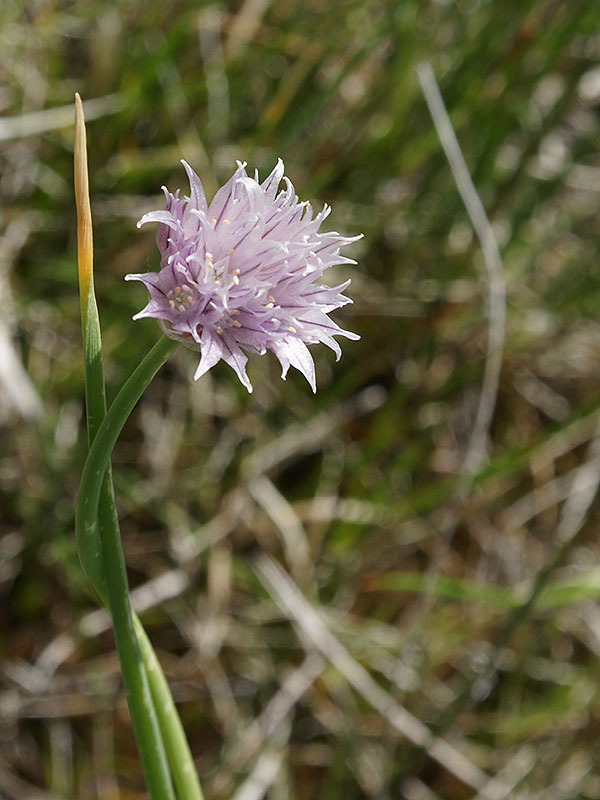Allium schoenoprasum / chives
- globe-shaped umbels of pink flowers with darker midveins (stripes)
- hollow, tubular leaves and flower stalks
- smells like onions
- grows from bulbs in clumps or sometimes individually
- wild in wetlands, fens, meadows; cultivated in gardens
Also known as: wild chives
“He who bears chives on his breath, Is safe from being kissed to death.” – Marcus Valerius Martialis
Identification of this species was hard for me for quite a while because I did not realize that chives is actually a native to North America. I thought it was “just” a garden thing. I have lots of recipes that use chives, and I know they are a pain in the garden if you don’t top them before they set seed, but I never thought I’d find them as I walked across a fen.
Actually, there are both native and introduced chives and it is difficult to impossible to distinguish native from escaped populations. Location is one thing correlated, however. Native populations tend to be found on river shores, in meadows (especially wet meadows) and fens/marshes. Introduced populations tend to be in disturbed areas, e.g. roadsides or vacant lots. Interestingly, those populations also seem to be susceptible to root rot if the soils are wet.
Chives are small-bulb perennials. The bulbs grow in dense clusters from the fibrous roots underneath them, although occasionally, as in the featured photo, plants in wet areas may grow individually rather than in clumps.
Chive flowers come in a variety of colors, the most common ones being pink to red. Or maybe lavender. They grow in an umbel at the top of round, hollow scapes (flower stems). The umbel itself is probably the only part that most of us actually see. Each flower is borne on a very short pedicel, but the pedicels are largely hidden when the flowers are open. Each flower has 6 tepals, 6 stamens and a pistil with a single white style. The tepals have fine lines of darker color, the midribs. A papery bract surrounds the whole inflorescence before it opens. The main blooming period is late spring and early summer, i.e. June and July.
Chive leaves are dark green and tubular, i.e. circular and hollow in cross section. They grow only from the tightly clustered bulbs at the base of the plants.
Chives reproduce both by seed (prolifically) and by offsets, i.e. the formation of new bulbs in the ground.
Interesting bits – Throughout the world, at least in northern areas, the bulbs, leaves and flowers of this species have long been used for flavoring foods such as fish, soups and salads. The flowers also add good color and flavor to things like omelets. A special note here… all species of Allium are edible, if you happen to be human. They are also poisonous to dogs and cats, and there are some lilies that look like onions but are not OK to eat. However, if it smells like an onion, it is an onion. And don’t eat too much, no matter if you are Père Marquette or not.
Another thing about smelling like an onion… the aroma deters such grazers such as deer, and tends to repel insects that might eat it or nearby plants of other species. On the other hand, chives provide a great deal of nectar for pollinators, including bees and flower flies. They must have bad sniffers.
The Indian word “Shikako'” or ”skunk place” is recognized as the origin of the name “Chicago”, referring to somewhere with some native wild onion, likely A. canadense or A. tricoccum (ramps). And in 1674, in their journey from Green Bay (but before the Packers played there) to the present site of Chicago (before the Bulls), Père Marquette and his companions subsisted largely upon the those two species. Note: this was before toothpaste.
Finally, in the 19th century, Dutch farmers fed chives to cattle to give a “different” taste to their milk. Nowadays, it’s called tainted.
